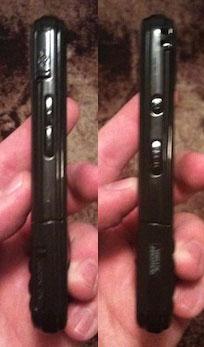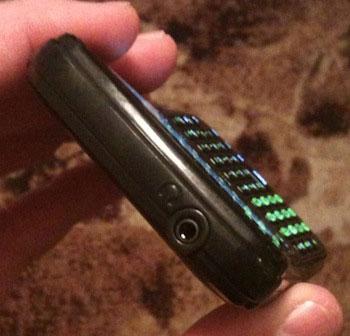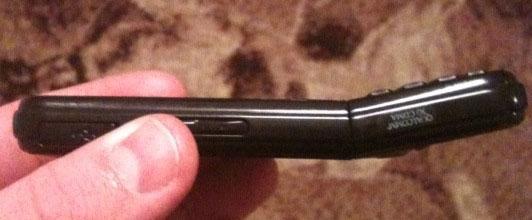What's Good: Battery life; keyboard is relatively easy to type on.
What's Bad: No 3G; 2.5mm headphone jack.

Though most wireless manufacturers prefer to stay within set design boundaries, it's nice to see a different phone every now and again. That being said, the PCD Razzle (branded as the Verizon Wireless Razzle) fits the mold. Offering a unique swiveling bottom that rotates 180 degrees to offer a full QWERTY keyboard, the Razzle is clearly marketed toward the heavy messaging crowd. With the lack of 3G connectivity, it's not going to win the hearts of data-centric users, but for those who are looking for a decent entry-level handset, the Razzle may be just what the doctor ordered.

The left spine of the Razzle contains the microUSB charging port, volume rocker, and a microSD card slot. The right side sports a lanyard hole, camera button, and a mobile web/screen lock key. The front of the device sports two shortcut buttons, a speakerphone button, clear key, a d-pad, ok button, send, and end key. The camera is located on the back of the device, and a 2.5mm headphone jack can be found on the top of the unit. The Razzle is unique in that the bottom half of the keyboard rotates 180 degrees, offering the user the option of multimedia buttons or a full QWERTY keyboard. When rotated into QWERTY mode, the device offers a lip reminiscent of the European HTC Hero.

Like most entry-level devices, packaging is minimalist. offering the device, battery, wall charger, USB cable, 1 GB microSD card (installed in phone), and instruction manuals. Coming in at 2.4-inches wide by 4.5-inches long by 0.5-inch thick, the Razzle weighs a reasonable 3.8 ounces, making it light and easy to carry around on a regular basis. The 2.2-inch LCD display houses 262,000 colors and 220 x 176 pixels.
Like most non-smartphone devices in Verizon's lineup, the Razzle ships with the carrier's stock user interface. Customization is reasonable, with the choice of four display themes and 13 wallpaper options. Font sizes can be selected for dial fonts and menu font sizes, and main menu settings offer users the ability for icons to be viewed in tab, list, or grid layout. The Razzle supports instant messaging and mobile e-mail, with the latter costing $5 monthly. Ringtones, tones, sounds, and graphics are pre-installed for customization purposes, with the option of purchasing additional content through Verizon's storefront.

The Razzle's strength is in its music player, and it performs admirably in the department. The buttons on the front of the device act as music keys, offering a shortcut key, back/rewind, play/pause, and forward. In addition to creating custom playlists, music can be filtered by artists, genres, and albums. For those that travel frequently, a "Music-Only" mode (i.e. Airplane Mode) allows you to turn the Razzle's wireless radio off in order to listen to music while in flight. Due to the lack of 3G connectivity on the unit (more on that later), V CAST Music with Rhapsody is not installed. While on the topic of media, the Razzle ships with a megapixel camera and self-portrait mirror. In my testing, most pictures were poor, unless there was adequate natural lighting. Photo options include six white balance presets, four resolutions, a self-timer, four color effects and four shutter sounds. The Razzle doesn't offer a video camcorder.

I tested the Razzle in the Charlotte area, and call quality was good. Not only was call quality strong on my end, but callers reported similar results. When I went to a known Verizon fringe spot in the area, I found calls to sound mostly clear, despite the occasional choppiness. I successfully paired the Plantronics Voyager Pro Bluetooth headset to the device without issue, and Bluetooth functionality worked well throughout testing. The speakerphone was a mixed bag. Though quite good on my end, several callers noted that I sounded muffled, and in many instances I had to speak up. When testing the device in a grocery store, I was able to hear my callers well.

Surprisingly, the Razzle is a 1xRTT device, meaning that it doesn't offer 3G connectivity. CNN Mobile loaded in 38 seconds, and the PhoneDog homepage loaded in just under a minute. The only thing I was less than impressed with was the method of entering URL's. Instead of a built-in option, the phone requires you to go back to a URL-entry page each time you want to input a website. After browsing for more than ten minutes, it gets a bit irritating.

Estimated talk time is 4.8 hours, and in my testing, battery life was quite good, due in part to the 1X connectivity. With moderate use encompassing text messaging, calling, e-mail, and light web browsing, I was able to use it just under two days before the low battery warning flashed. With little to no use, the device lasted over three days. Like any wireless device, battery numbers will vary with the level of usage that they're subjected to between charging cycles, but the Razzle should be fine for the average consumer. For those frequently away from home, school, or the like, there are other devices that may suit you better.

Sure, the Verizon Wireless Razzle isn't going to appeal to everyone. With a distinct design, it's clear that the device is marketed towards the texting teenager versus the corporate professional. Perhaps the most frustrating issue with the Razzle is the lack of 3G. While the argument of "not everyone needs 3G" is valid, a device shipping without it in 2009 is a bit unacceptable. I'm also frustrated with the decision to utilize a 2.5mm headphone jack instead of the standard 3.5mm configuration. Barring those two issues, the Razzle is a decent entry-level handset that would fit the bill for most. The keyboard is relatively comfortable and easy to use, and it offers decent media functionality.
